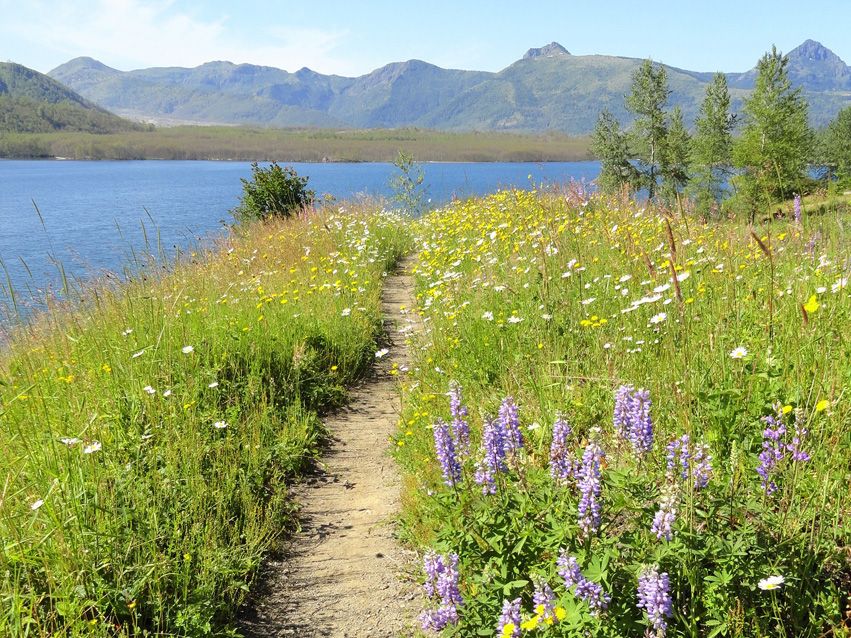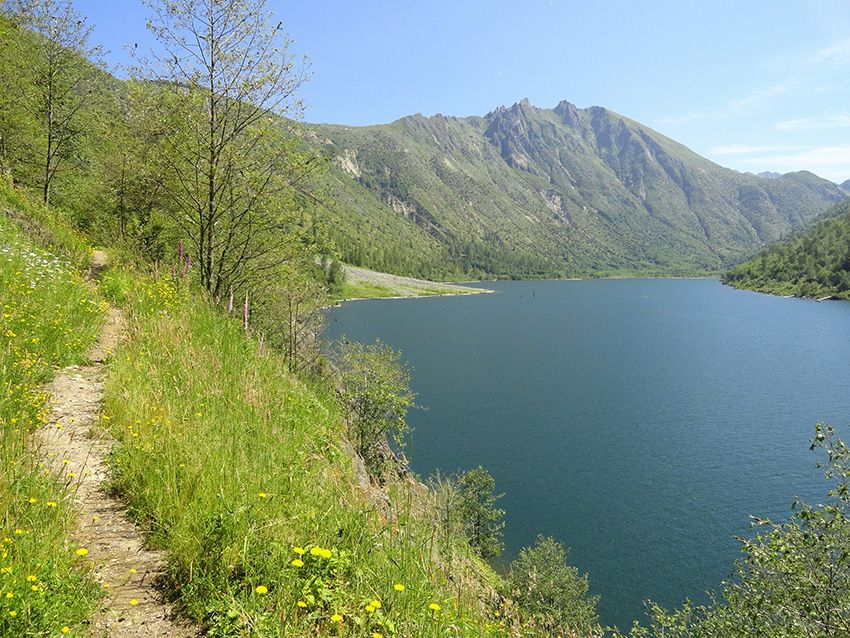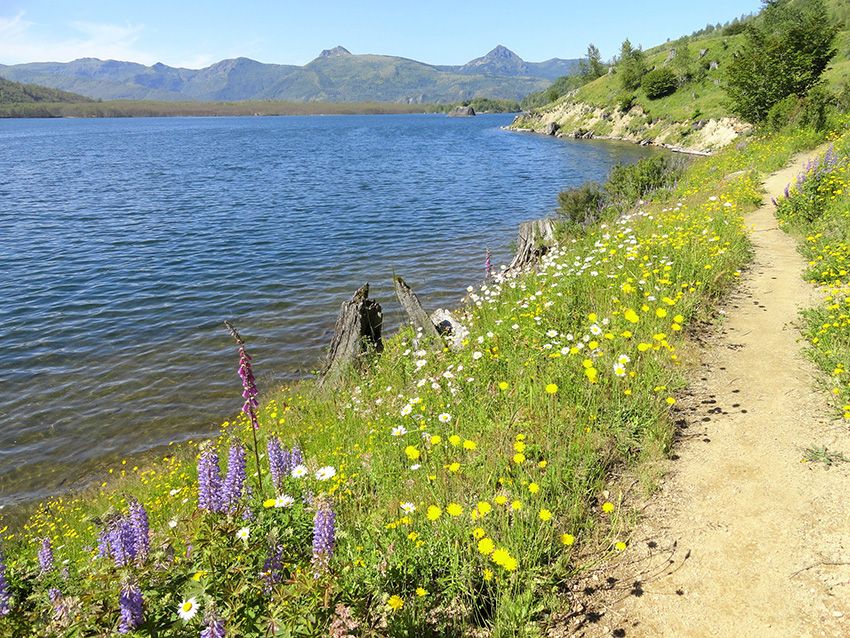
by Craig Romano
Roundtrip: 9.0 miles
Difficulty: moderate
Elevation Gain: 550 feet
High Point: 2,625 feet
Best Season: Late spring—early summer
Trail Notes: Northwest Forest Pass (or interagency pass) required; No dogs; kid-friendly; no camping; trail is also open to mountain bikes; off-trail travel prohibited. Always practice Leave No Trace Principles
Trail Highlights: Sparkling eruption-made lake, prolific wildflowers, excellent early and late season snow-free hiking option; exceptional elk habitat
The Lakes Trail (no. 211) travels for more than 13 miles across some of the most stunning backcountry within the Mount St. Helens National Volcanic Monument. From its western terminus at the Coldwater Lake boat launch to Elk Pass at the eastern gate of the Mount Margaret Backcountry—this trail traverses the shoreline of a half dozen lakes. Nearly a third of that distance is along massive Coldwater Lake.
Formed when debris and earth from the 1980 eruption dammed Coldwater Creek, Coldwater Lake is now more than four miles long and 200 feet deep. Wildlife is abundant along its shores. The views are continuous. Wildflowers are prolific from late spring through the summer. And surrounding mountains and ridges beautifully reflect on the lake’s waters when placid—or mirror rippling images when breezes funnel down from the surrounding slopes.

One of the best features of the westernmost stretch of this trail is that it’s often free of snow by early spring allowing hikers a decent taste of the Mount St. Helens backcountry early in the season. And while the westernmost four miles of this trail run along Coldwater Lake from its outlet to its inlet—don’t be deceived into thinking the way is level. Lakeside ledges and steep slopes will have you heading up and down on several occasions. You’ll gain and lose more than 500 vertical feet on the out-and-back.
Locate the trailhead just west of the boat launch and begin your journey along sprawling Coldwater Lake—the second largest lake within the monument. The trail travels through former clear-cuts and across the blast zone. What was a stark environment in the early 1980s is now a vibrant recovering ecosystem. The resiliency of nature is on full display here from flowered slopes to shady emerald groves of alders, willows, and cottonwoods.
Immediately following alongside the lake, take in good views of Mount St Helens and little Hummock Island. Throughout the hike, enjoy good viewing of surrounding Coldwater Peak and the stark southern face of Minnie Peak. In less than a mile come to a junction with the Elk Bench Trail. This recently resurrected trail climbs 600 feet in one mile on its way to the Coldwater Science and Learning Center. It’s a good workout, often void of fellow hikers and it offers some pretty decent views of Coldwater Lake.
The Lakes Trail continues its northeast journey along Coldwater Lake soon coming to a wonderful resting spot right at water’s edge. This is a perfect spot to call it a day for a short hike. It’s also a perfect spot for restless young children to while away the afternoon as swimming is permitted here—although you probably won’t be thinking about taking a dip until much later in the season.
Keep hiking passing some fallen giant firs. They are reminders of the grand forest that once stood here before logging and nature ravaged it. But as pioneering alders now grow tall awaiting the next successional stage, a grand forest will once again grace these shores a couple of human lifetimes from now. The way comes to the first of several creeks of varying sizes that need to be crossed. Most can be hopped across, but expect wet feet during rainy periods and times of heavy snow melt.
About two miles into the hike cross a creek donning a pretty little waterfall. Then skirt some cliffs before negotiating steep ledges hovering high above the lake. Watch your footing here and keep children close by as the drop off is substantial. The trail then begins a descent reaching a wide rocky outwash. Follow cairns across the open rocky and sandy terrain eventually coming to flowered flats at lake level. A short side trail branches right to a sandy shoreline. Nesting spotted sandpipers can often be sighted here.
The trail continues across the flat reaching the lake’s marshy eastern end. Look for beaver activity here among the alder thickets. Leaving the lake, the trail now follows Coldwater Creek. Gently climb a couple hundred feet and pass beneath some massive fallen firs before reaching a junction with the Coldwater Trail at 4.5 miles. This is a good spot to turn around—but before doing so, consider walking a short distance south on the Coldwater Trail to a sturdy bridge spanning the thundering creek. Here admire the creek cascading through a tight chasm—then cast your eyes upward to stone gargoyles peering down upon you from stark faced Minnie Peak. As shadows lower in the valley, start your return back to your vehicle.

Directions to Trailhead
From Castle Rock follow SR 504 east for 45 miles turning left into the Coldwater Lake Recreation Area. Continue .4 mile bearing left to boat launch and trailhead.
Trail Resources
Map: Green Trails Mount St Helens 332S
Guidebook: Day Hiking Mount St. Helens by Craig Romano and Aaron Theisen (Mountaineers Books)
Managing Agency: Mount St Helens National Volcanic Monument
Treading Softly on the Land
Many of Mount St. Helens’ trails have recently seen a huge uptick in use due in no small measure to viral Social Media posts. While it’s great to see many new folks exploring our public lands—large numbers of trail users—and particularly users not versed in proper trail and backcountry etiquette are having adverse effects on our parks and trails. Before you post a pretty picture that has the potential of going viral and creating even more crowding and inviting even more folks unaware of Leave No Trace principles and trail etiquette; consider the consequences. In your posts, encourage and model being prepared and knowledgeable about recreating in the natural world. Encourage folks to try lesser known trails and to disperse their use. And never post and promote activities on the trail that are counter to Leave No Trace Principles. Social Media can be a powerful tool too for promoting sound and sustainable conservation practices.

ABOUT THE AUTHOR
Craig Romano is an award-winning author of more than 20 guidebooks with Mountaineers Books. One of the most prolific trails writers in Washington, he has hiked more than 25,000 miles in the state from the Olympics to the Blues. Visit him at: CraigRomano.com